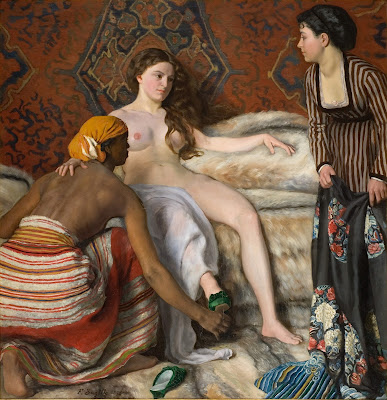17th February - 22nd May 2016
The
Sainsbury Wing’s newest guest is the French painter Eugene Delacroix,
known for his impassioned works of Romantic art. Their current exhibition captures his
influence on iconic modern painters such as Matisse, Van Gogh and Courbet. With
a diverse array of floral, allegorical and religious scenes, Delacroix’s
expansive subject matter knows no bounds, but the exhibition lacked enough of
the stronger works by the artist himself. Despite being taught by the
Neo-classical painter Guerin, Delacroix drew more from the colour and movement
of Rubens and the Venetian Renaissance than the perfection of Ingres. In terms
of style, Delacroix carved his own path as he distorted the anatomy of his
figures, heightened colours and used techniques often considered undisciplined
and idiosyncratic by his contemporaries.
In
the words of the French poet Charles Baudelaire, "Delacroix was passionately in love with
passion, but coldly determined to express passion as clearly as possible."
With his penchant for the dramatic, Delacroix’s work was often controversial,
but it was also that tension between the opposition and his enlightened
supporters, which made his oeuvre so beguiling. On a lighter note, the first
room of the exhibition is home to a naturalistic portrait of Louis
Auguste Schwiter 1826. The handsome
young man poses in nature with a textured white cravat illuminating his
inquisitive eyes and a romantic landscape disappearing into the background.
But, as you progress the subject matter diversifies. Not only did Delacroix
draw from classical models of Greek and Roman art in his work, but he also
travelled to countries like Spain, Algiers and Morocco in pursuit of the
exotic, the dramatic.
In
the days before the camera, Delacroix sought the ‘living antiquity’ in large
canvases painted of his travels from memory back in Paris. In Convulsionists of Tangier 1838 he
captured the trance-like state of religious fervour experienced by the crowd
during the annual procession of Aissoua. Disappointingly, the National Gallery
weren’t able to obtain more of his larger masterpieces from museums such as the
Louvre offering us only ‘reduced replicas’ of The Death of Sardanapalus 1827 or the seductive Women of
Algiers in their Apartment 1834. At least the
latter was reflected in Frederic Bazille’s La
Toillette 1870, a nod to Orientalism. Except the setting was more likely a
Parisian brothel than Algiers given the presence of the Western woman and the
Chinese robe she offers the nude protagonist.
From 1847, Delacroix kept extensive
journals in which he considered artistic techniques and reflected upon both his
travels and experiences in Paris. These journals became a blueprint for the modern
artists who worshipped him and followed in his creative path. Signac and
Matisse would reportedly read them to one another. Van Gogh also drew from
Delacroix’s sense of colour with the lemon and Prussian blue paint combined
with impassioned, directional brushstrokes in his Post-impressionist work Pieta (after Delacroix) 1889. Given that
he modeled the red-haired Jesus on his own face, it is unsurprising that Van
Gogh’s brushstrokes were frenzied as if illustrative of his personal suffering
in the asylum where he painted it.
Competing
with Claude Monet’s contemporaneous exhibition at the Royal Academy,
Delacroix’s flower paintings were commanding a considerable audience. As his
career progressed, paintings like the chromatic Basket of Fruit in a Flower Garden 1848 had become vehicles for his passionate feelings – you can
almost smell the petals. Baudelaire thought Delacroix’s paintings were both
dangerous and beautiful as he addressed the needs of the senses before the
subject. In admiration of his botanical works, the French painter Ignace Henri Theodore Fantin Latour painted
Tannhauser: Venusberg 1864 inspired
as much by Wagner’s opera as Delacroix’s Romantic colour palette with ethereal
women in soft reds and pinks frolicking in nature.
Delacroix
was inspired by the poetry of Lord Byron with whom he shared a strong
identification with the "forces of the
sublime", of nature in violent action. In Christ on the Cross 1853 we see Christ against a stormy sky in a
work with the emotional intensity that Delacroix thought hailed from the speed
of its composition. Continuing the religious theme, I was intrigued by the
dream-like quality of St Sebastian unbound
by the Holy Women, 1869 by the
Symbolist visionary Gustav Moreau who often visited Delacroix’s Paris studio.
Influencing a plethora of young painters, Delacroix was an icon of the
avant-garde, a self-taught painter with an interest in colour.
Written by Flora Alexandra Ogilvy, founder of Arteviste.com









No comments:
Post a Comment